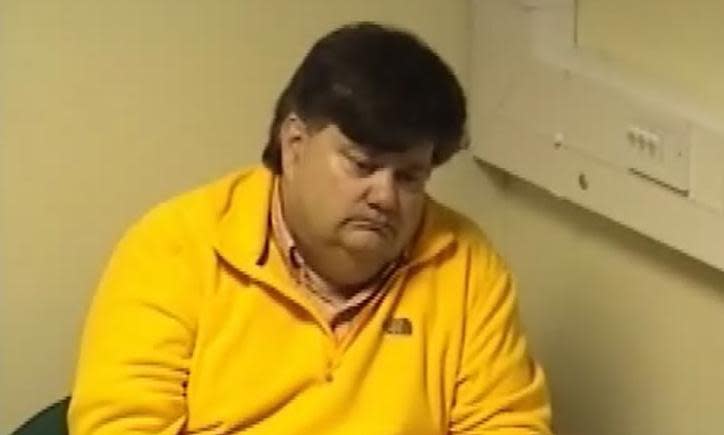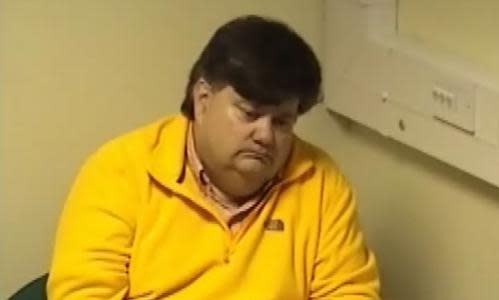Paedophile Carl Beech gave NSPCC talks to children about abuse
The VIP paedophile ring accuser Carl Beech gave talks to children as young as five about the dangers of abuse on behalf of the NSPCC, it can be revealed.
Beech, himself a convicted paedophile after pleading guilty to hoarding indecent images of children and spying on a teenager urinating, volunteered for the charity by delivering assemblies and workshops to young children.
At the same time as he was going to police with his false claims about a murderous gang of high-profile abusers, Beech spoke to key stage 1 and 2 pupils at dozens of primary schools in Herefordshire as part of the NSPCC’s Speak Out Stay Safe scheme.
Related: Revealed: how Carl Beech, the serial child abuse accuser, became the accused
The 51-year-old father of one, who was also governor of two schools, volunteered for the NSPCC from November 2012 until July 2015. It is understood the charity was aware that Beech’s allegations had triggered Operation Midland, which was launched in November 2014, although he is not thought to have referred to his own experiences during the school talks.
He formally resigned and handed in his ID in February 2017. The charity said it had received no complaints about his behaviour while he was volunteering. In total, he volunteered at 33 schools for the NSPCC.
The programme’s synopsis says: “Trained NSPCC volunteers and staff deliver an assembly and workshop with the help of our Speak Out Stay Safe mascot, Buddy the speech bubble. Pupils are taught in a lively, memorable and child-friendly way.
“It’s an effective way to support your school’s safeguarding duties and links directly to the curriculum. By the end of our visit, children feel empowered – knowing how they can speak out and stay safe.”
Following the verdict, an NSPCC spokesman said: “Beech had no connection with the NSPCC when these offences came to light. Our volunteers are subject to the most strenuous and thorough safeguarding checks.
“We are shocked and appalled by today’s verdicts and hope Beech’s actions don’t prevent other abuse survivors from getting the justice they deserve.”
As part of the investigation into Beech for perverting the course of justice over his paedophile ring claims, Northumbria police raided his home in late 2016 and discovered 350 indecent images of children, dozens of which were graded category A – the most serious level. He had also secretly recorded a teenage schoolboy using the toilet.
Software that could disguise “forensic footprints” had been used on devices. Police also found 21 indecent photographs of children hidden behind a calculator app on an iPad. He was charged in June 2017 with four counts of making indecent photographs of children, one count of possessing indecent images of children and one count of voyeurism.
After failing to turn up for his trial at Worcester crown court in July 2017 and going on the run in Sweden, he was eventually extradited back to the UK to face justice after being captured.
When confronted with the evidence, he initially lied to investigators and sought to frame his teenage son for the child abuse images, at first pleading not guilty before switching his plea and accepting he was responsible as he was due to face trial in January 2019.
Meanwhile, Beech’s role in helping kickstart a charity exhibition highlighting child abuse survivors’ stories, which went on show at City Hall in London, can be disclosed in full for the first time.
The Wall of Silence collated survivors’ pictures, stories, poems and mementoes in a display in order to help them “overcome the aftermath” of abuse.
The wall was also displayed at Avon and Somerset police headquarters in 2016 and was due to be exhibited at the Houses of Parliament last year before permission was withdrawn after concerns were raised about Beech’s involvement.
The exhibition was established by the Southmead Project, a Bristol-based charity that provides support to child abuse survivors who have turned to drugs, alcohol or self-harming, but was spawned by Beech’s efforts on social media.
Beech used an anonymous Twitter account to communicate with child abuse survivors to collect their images, stories and other content, which he published on his blog.
Dr Mike Peirce, who founded and runs the Southmead Project, said Beech’s blog had kickstarted the idea for the wall and he had first started speaking to him in 2015 before eventually meeting him later that year.
However, he said the Wall of Silence would be dismantled and he felt betrayed by Beech. “I’m on the wall. As a survivor, I’m devastated,” he said. “It has triggered trauma and my guess is it would have triggered the trauma with so many other people, their despair.”
It all started out positively, Peirce explained. “Carl Beech introduced the online concept of raising awareness of child abuse. From his concept, which he himself had gotten from the beautiful poppy field commemorating the fallen, he had followed that idea but came up with a way of victims and survivors of child abuse being remembered too for their suffering.
“I thought it was a beautiful idea and I looked at it and I thought there’s much more that can be done about this.”
Peirce said he had met Beech several times and corresponded with him over email and Twitter. “The Twitter response was amazingly positive to what he was trying to do. He invited people to send him how they depicted themselves, either a poem, picture, whatever way they wanted. There was enormous variation,” he said.
“They had sent in those pictures willingly. He had then put them online.”
Peirce said he had developed Beech’s idea into the Wall of Silence, which first went on display in January 2016 in Bristol and the following month at City Hall in London, the headquarters of the Greater London authority.
It was due to be exhibited at parliament’s upper waiting hall in April 2018 until concerns were raised over Beech’s involvement. The Tory MP Sir Paul Beresford, the chair of the administration committee, wrote to Peirce informing him that permission had been withdrawn for the exhibition. Without mentioning Beech by name, Beresford wrote: “This decision was taken in light of the current controversy surrounding the exhibition.”
He added that “concerns have been raised” in relation to the display but that “the committee’s decision in no way indicates that any judgment has been made by the House of Commons about the veracity of any of the claims made about the exhibition”.
Peirce stressed Beech was not a client of the project and that he had not know about Beech’s allegations other than that he had said he was a child abuse survivor. The charity founder, a counsellor with nearly 30 years’ experience, added: “It’s a tragedy. I was taken in by a person. To be completely taken in, I felt extremely gullible.
“The tragedy for me, not just me personally, is that I know the damage this has done and the potential damage it could do to raising genuine awareness.”
In all, Beech published 57 blogposts, including one in which he said he was “amazed at the almost daily increase in people following me on Twitter” and “humbled by the kind comments from survivors”.
He also began writing his own memoirs and spoke at a conference as a survivor of sexual abuse.

 Yahoo News
Yahoo News 

